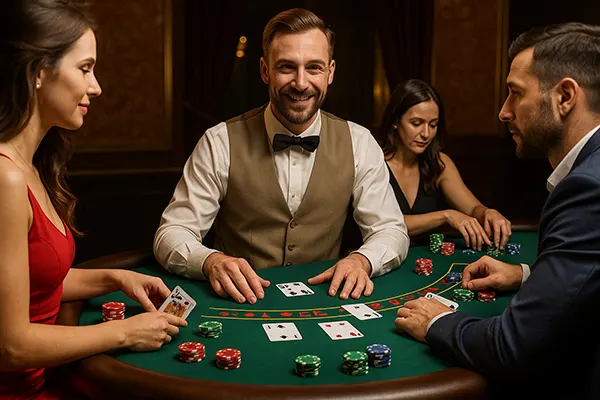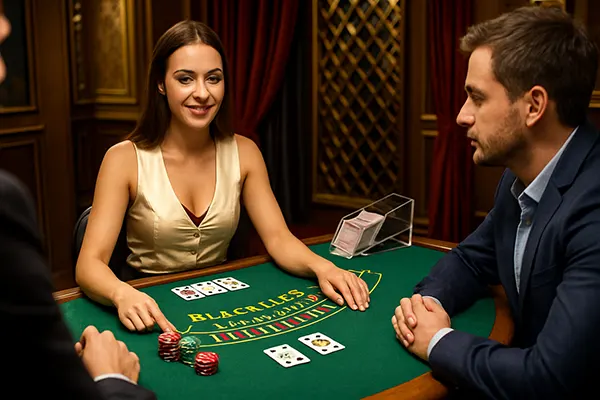Blackjack in Live Casinos: How Strategy Changes with a Real Dealer

Live blackjack introduces a unique dynamic into the world of gambling. Unlike digital versions of the game, live blackjack relies heavily on real-time interaction with a human dealer, which influences both psychological perception and strategic decision-making. For seasoned players, the presence of a real croupier can either enhance their edge or expose weaknesses in their gameplay routine. This article explores how the strategy shifts when blackjack is played at a live casino table, based on behavioural cues, timing, and pressure in a real environment.
Human Interaction: Reading the Dealer and Table Behaviour
One of the most significant changes in strategy when moving from digital to live blackjack is the possibility of reading the dealer. Although dealers are trained to maintain a neutral expression, subtle cues such as hesitations, tone, or hand movement may unconsciously reveal valuable information. This isn’t about card counting—it’s behavioural psychology.
Furthermore, the rhythm of the table plays a role. In a live environment, players respond to the actions and tempo of others. If a player hits aggressively on borderline hands, it might influence neighbouring players to be more conservative. Adjusting your rhythm and decision-making based on dealer actions and peer influence is crucial in this environment.
Strategically, observing the dealer’s routines and the overall energy at the table can help experienced players decide when to sit out, change tables, or alter their betting patterns. These are nuanced decisions, but they can make a considerable difference in long sessions.
Adapting Strategy Based on Dealer Consistency
Some players monitor the consistency in a dealer’s card distribution. While this is not about superstition, patterns can be noted for confidence building or withdrawal timing. If a dealer shows repeated streaks of strong upcards, it may warrant a conservative approach.
Similarly, dealers with steady hands and quick deals often indicate fewer distractions, leading to faster rounds. Players who thrive under quick conditions may adopt a more aggressive betting style during these sessions. On the other hand, slower-paced dealers allow more time for mental calculations and revisiting basic strategy deviations.
Using these micro-observations, experienced players evolve their style from rigid strategy to adaptive play, combining statistical understanding with observational insight.
Table Talk, Pressure, and Social Influence
In a live casino, social pressure is a subtle but significant influence on blackjack strategy. When playing alongside others, especially in high-stakes settings, some players alter their decisions to align with perceived group consensus—even if it contradicts basic strategy charts.
Verbal interactions with the dealer or players can disrupt your focus or reinforce your choices. Some players intentionally chat with the dealer to distract opponents or to reduce tension, while others prefer silence to maintain concentration. Each approach requires different mental discipline.
Importantly, bluffing doesn’t exist in blackjack the way it does in poker, but psychological pressure can influence betting behaviour. For example, a player might double down with marginal hands just to maintain an aggressive image at the table.
Maintaining Composure Under Observation
Live blackjack requires more emotional control than online versions. Every decision is public. Other players can critique, mock, or praise your plays, which can push some gamblers away from optimal strategy into emotion-driven choices.
Developing a psychological barrier from surrounding comments is essential. This means sticking to your game plan regardless of peer influence. For serious players, having a pre-determined threshold for betting and deviation from strategy helps avoid impulsive errors caused by social pressure.
The ability to reset mentally between hands and remain unaffected by group outcomes is often what separates a professional approach from casual play in live blackjack environments.

Timing, Dealer Pace and Strategic Pacing
Another factor that shifts in live blackjack is timing. Unlike software-based versions where decisions are time-capped and rapid, live tables vary in speed depending on dealer efficiency and player responsiveness. This changes the flow of decision-making.
Players must develop patience and maintain focus across prolonged intervals. Live play often includes slower dealing and intermissions, especially when the table is full. During these periods, players can review hand history and mentally prepare for the next round, using downtime as strategic advantage.
Conversely, a fast-paced dealer can put pressure on those who rely heavily on charts or calculations. It forces intuitive gameplay, where only deeply embedded knowledge of the game supports optimal choices under pressure.
Strategic Discipline During Fluctuating Game Speed
Maintaining consistent strategy in fluctuating game speeds requires experience and self-awareness. During slower sessions, some players get bored and become overly aggressive to ‘keep things exciting’—a dangerous habit that breaks disciplined play.
On the other end, fast games can lead to rushed decisions. A player might skip double down or split opportunities due to time pressure, especially when multitasking mentally. Learning to manage tempo without compromising mathematical advantage is a crucial skill in live blackjack.
Practicing hand scenarios offline and running simulations help prepare players for tempo variations. This ensures they maintain a clear decision-making framework even when the table dynamic changes rapidly.
